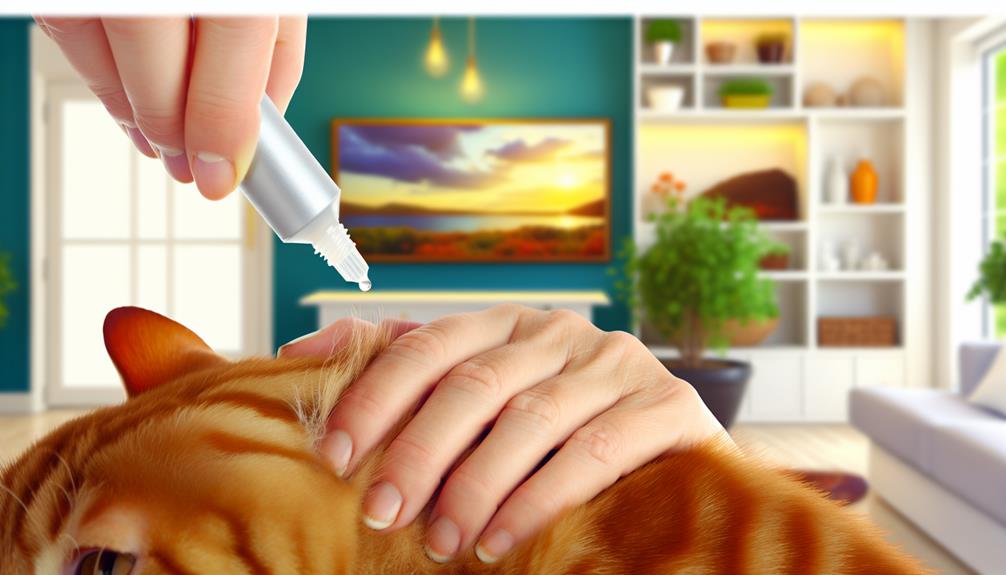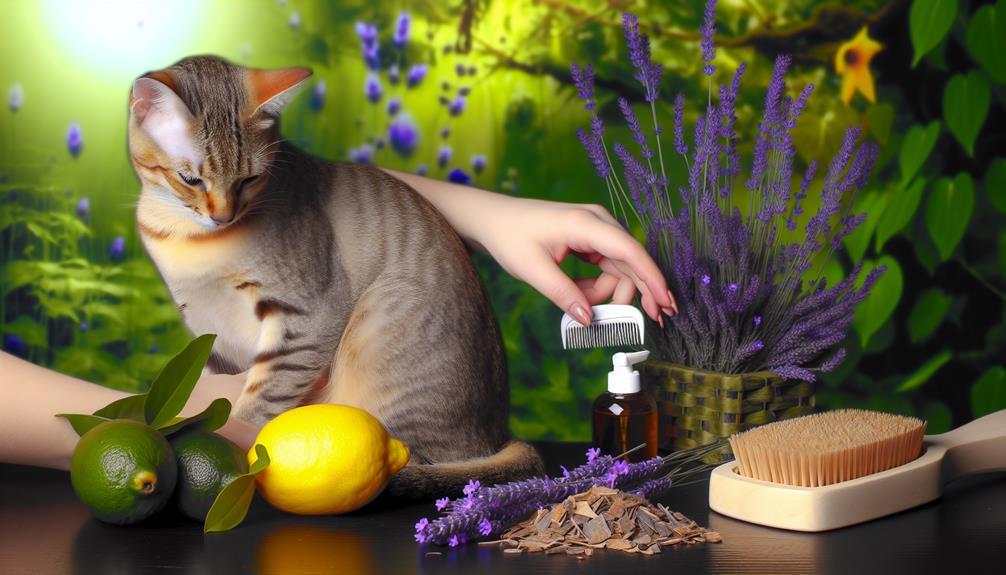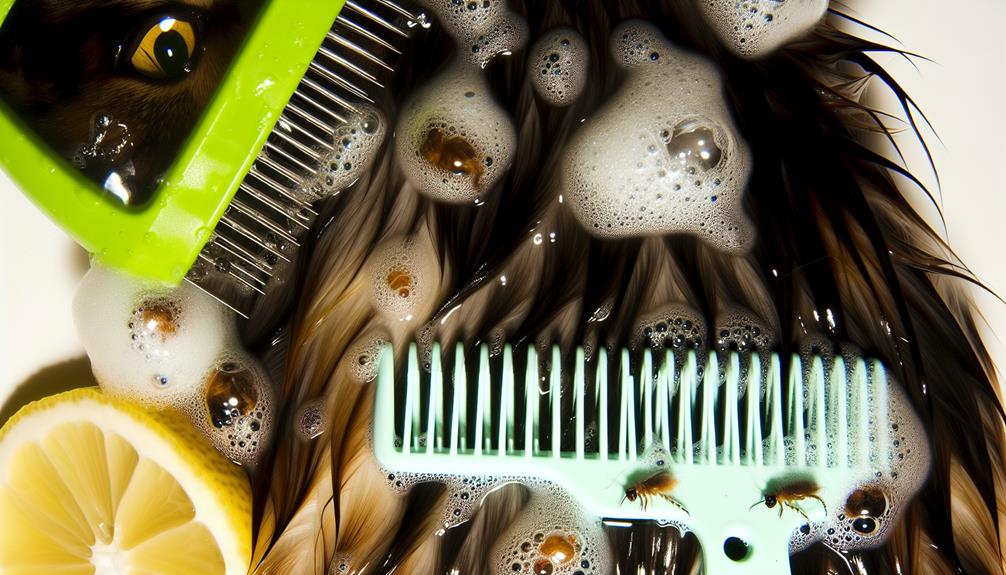It's funny you bring this up, because just last week, I noticed my cat scratching more than usual. If you're dealing with the same issue, you're probably searching for effective ways to get rid of fleas on your cat. You might start by using a fine-toothed flea comb to catch those pesky insects and their dirt. But that's just the beginning. Have you considered how topical treatments or oral medications might play a role? And what about maintaining a flea-free environment at home? Let's explore what could make a real difference in your battle against fleas.
Identify Flea Infestation
Before you can effectively combat a flea infestation on your cat, you need to accurately identify the problem. Understanding flea behavior and their life cycle is essential for this process. Fleas go through four developmental stages: egg, larva, pupa, and adult. Without recognizing these stages, you might miss signs of an infestation.
First, observe your cat for excessive scratching, grooming, or visible discomfort. Fleas bite and feed on blood, causing itching and irritation. Adult fleas are small, dark brown insects that move quickly through the fur. You might see them jumping, as fleas are capable of impressive leaps due to their strong hind legs. Flea dirt, which resembles tiny black pepper flakes, is another indicator. This is actually flea feces, composed of digested blood, and can be found on your cat's skin and bedding.
To confirm the presence of fleas, examine areas where your cat spends most of its time. Flea eggs are tiny and white, often falling off the host and accumulating in the environment. These eggs hatch into larvae, which are small and worm-like, feeding on organic debris, including flea dirt. Once they mature into pupae, they form a protective cocoon, making them hard to eliminate.
It's important to note that adult fleas represent only about 5% of the total flea population; the remaining 95% are in the egg, larva, or pupa stages. Consequently, even if you see only a few adult fleas on your cat, there could be a substantial underlying infestation. By understanding these aspects of flea behavior and their life cycle, you'll be better prepared to address and eradicate the infestation effectively.
Use Flea Combs
A flea comb is an invaluable tool in your fight against flea infestations on your cat. This specialized comb, with its fine teeth, is designed to physically remove fleas, flea dirt, and eggs from your cat's fur. Utilizing this tool effectively can disrupt the flea lifecycle and provide immediate relief to your pet.
When using a flea comb, follow these combing techniques to maximize its effectiveness:
- Choose the Right Time: Select a time when your cat is calm. This minimizes stress and allows for a more thorough combing session.
- Prepare a Soapy Water Solution: Have a bowl of soapy water nearby. Dip the comb in this solution after each pass to kill any captured fleas instantly.
- Comb Methodically: Start at your cat's head and work your way to the tail. Confirm you cover all areas, particularly around the neck and base of the tail, where fleas often congregate.
- Check and Clean the Comb Frequently: Inspect the comb after each stroke. Remove any fleas or debris, and dip the comb back into the soapy water to confirm it remains effective.
- Monitor and Repeat: Regularly comb your cat, especially during peak flea season. Consistency is key to breaking the flea lifecycle.
Topical Treatments

When dealing with flea infestations on your cat, topical treatments offer an effective and targeted approach to eliminate these pests. These treatments, often administered via a small tube, are applied directly to the cat's skin, typically at the base of the neck. This method of topical application guarantees the medication is absorbed into the bloodstream, providing systemic protection against fleas.
Topical treatments are highly regarded for their flea effectiveness. They often contain active ingredients such as fipronil, imidacloprid, or selamectin, which interfere with the flea's nervous system, leading to paralysis and death.
| Topical Treatment | Active Ingredient | Duration of Effectiveness | Application Frequency |
|---|---|---|---|
| Frontline Plus | Fipronil | 30 days | Monthly |
| Advantage II | Imidacloprid | 30 days | Monthly |
| Revolution | Selamectin | 30 days | Monthly |
| Seresto Collar | Imidacloprid | 8 months | Bi-annual |
Each of these treatments is designed to provide continuous protection, typically for a duration of one month, though some options like the Seresto collar extend up to eight months. The monthly application guarantees that any new fleas coming into contact with your cat are promptly eradicated.
To maximize flea effectiveness, it's essential to follow the manufacturer's instructions precisely. Incorrect application can reduce efficacy, leaving your cat vulnerable to re-infestation. Additionally, you should confirm the treatment is specifically formulated for cats, as some products meant for dogs can be toxic to felines.
Using topical treatments as part of a thorough flea control strategy can greatly reduce the flea population on your cat and in your home, providing relief and protection for your furry friend.
Oral Medications
Although topical treatments are effective, oral medications provide an alternative that guarantees systemic flea control through ingestion. These medications circulate within your cat's bloodstream, attacking fleas at every stage of the flea life cycle—eggs, larvae, pupae, and adults. This thorough approach guarantees that fleas are eliminated not just on the cat's skin but throughout their entire system.
Administering oral flea medications is straightforward, usually involving a chewable tablet or pill. The active ingredients, such as spinosad or nitenpyram, work by interfering with the flea's nervous system, leading to rapid death. Here are some critical considerations for using oral medications:
- Efficacy: Oral medications have been shown to kill fleas rapidly, often within 30 minutes to a few hours of ingestion.
- Systemic Action: Since the medication is ingested, it guarantees that fleas cannot escape by hiding in less accessible areas of your cat's body.
- Long-lasting Protection: Depending on the specific medication, protection can last from 24 hours up to a month, reducing the need for frequent reapplication.
- Flea Life Cycle Interruption: These medications can effectively break the flea life cycle, preventing eggs from hatching and larvae from maturing.
- Medication Side Effects: While generally safe, some cats may experience side effects like vomiting, lethargy, or loss of appetite. Always consult your veterinarian before starting any new medication.
Natural Remedies

Natural remedies can offer an alternative approach for flea control on cats, leveraging substances that are generally considered safer for both pets and humans. One of the most effective natural methods involves herbal solutions. These can include various plant-based treatments such as neem oil, which has been shown to possess insecticidal properties. Its active compounds interfere with the lifecycle of fleas, thereby reducing their population over time. Another herbal remedy is diatomaceous earth, a fine powder made from fossilized aquatic organisms. When applied to your cat's fur, it can dehydrate and kill fleas by damaging their exoskeleton.
Essential oils also play a significant role in natural flea control. However, it is essential to recognize that not all essential oils are safe for cats. Oils like lavender, eucalyptus, and cedarwood can be used in diluted forms to deter fleas. To apply, mix a few drops of the essential oil with a carrier oil such as coconut oil, then gently rub the mixture onto your cat's fur. This method not only repels fleas but can also provide a soothing effect on your cat's skin.
It is vital to exercise caution when using essential oils, as cats are particularly sensitive to certain compounds. Before application, always consult your veterinarian to verify that the specific oils and concentrations are safe for feline use. Additionally, frequent combing with a flea comb can help in physically removing fleas, complementing the herbal and essential oil treatments. By integrating these natural remedies, you can effectively manage flea infestations while minimizing potential side effects associated with chemical treatments.
Preventive Measures
To effectively prevent flea infestations, you should implement a regular grooming routine and utilize veterinarian-recommended flea prevention products. Consistently maintaining the cleanliness of your home environment will also reduce the likelihood of flea recurrence. These evidence-based strategies are essential for ensuring your cat remains flea-free.
Regular Grooming Routine
Your cat's health and comfort hinge greatly on a consistent grooming routine, a fundamental preventive measure against fleas. Implementing effective grooming techniques and utilizing essential tools can greatly reduce the risk of flea infestations. Regular grooming not only removes loose fur and dirt but also helps in detecting fleas early.
To establish a robust grooming routine, you should:
- Brush your cat's fur daily: Use a fine-toothed flea comb to remove any fleas or flea dirt. This tool is essential for penetrating through the fur and catching fleas.
- Inspect the skin: During grooming, check for red bumps, flea dirt, or any signs of irritation. This allows for early detection and intervention.
- Bathe your cat periodically: While not always necessary, bathing can help remove fleas. Use a cat-friendly shampoo that won't irritate the skin.
- Clean grooming tools regularly: Sanitize brushes and combs after each use to avoid reintroducing fleas.
- Maintain a clean environment: Fleas can thrive in dirty surroundings. Regularly vacuum your home, especially areas where your cat spends time.
Flea Prevention Products
When combating fleas, integrating flea prevention products into your cat's care regimen is vital. Flea collars, for instance, emit a continuous chemical barrier around your cat's neck and body, effectively deterring and killing fleas. These collars can provide long-term protection, typically lasting several months, depending on the brand and active ingredients. They are particularly useful for cats that are frequently outdoors, offering a proactive defense against infestations.
Flea sprays are another potent tool in your arsenal. These solutions can be directly applied to your cat's coat, targeting both adult fleas and their developmental stages. Many flea sprays contain insect growth regulators (IGRs) that inhibit the life cycle of fleas, preventing larvae from maturing into adults. This dual-action approach guarantees a thorough reduction in flea populations.
Choosing the right product requires attention to active ingredients and your cat's specific needs. Consult with your veterinarian to determine the most effective and safe options. Research indicates that using a combination of flea collars and flea sprays can notably reduce flea infestations, making sure your cat remains comfortable and healthy. Therefore, preventive measures are integral in maintaining a flea-free environment for your feline companion.
Home Environment Cleanliness
Maintaining a clean home environment is critical in preventing flea infestations on your cat. Fleas can easily spread through your home, making it essential to employ rigorous cleaning practices. Effective preventive measures include frequent vacuuming, washing bedding, and maintaining overall household cleanliness.
Regular vacuuming is imperative. High-traffic areas, carpets, and upholstered furniture should be vacuumed at least twice a week to eliminate flea eggs, larvae, and adult fleas. Additionally, focus on your cat's favorite spots and make sure you empty the vacuum canister outside, as fleas can escape.
Key Preventive Measures:
- Vacuum Frequency: Vacuum all floors and furniture twice weekly to disrupt the flea life cycle.
- Bedding Maintenance: Wash your cat's bedding in hot water weekly and dry it on a high heat setting to kill any remaining fleas or eggs.
- Curtains and Upholstery: Regularly clean curtains and upholstery, as fleas can hide in fabric folds.
- Outdoor Control: Maintain your yard by trimming grass and removing debris where fleas might thrive.
- Pest Control Services: Consider professional pest control treatments for severe infestations or if preventive measures are inadequate.
Incorporating these evidence-based strategies will considerably reduce the risk of flea infestations, assuring a healthier environment for your cat.
Conclusion
In summary, eradicating fleas on cats requires an integrated approach. By consistently using flea combs, topical treatments, and oral medications, you can greatly reduce infestations. For instance, a hypothetical case where a cat named Max had a severe flea infestation illustrates this: after employing a combination of vacuuming, flea collars, and diatomaceous earth, Max's fleas were eliminated within weeks. Remember, maintaining cleanliness and using veterinarian-recommended products are essential for long-term prevention and your cat's well-being.
